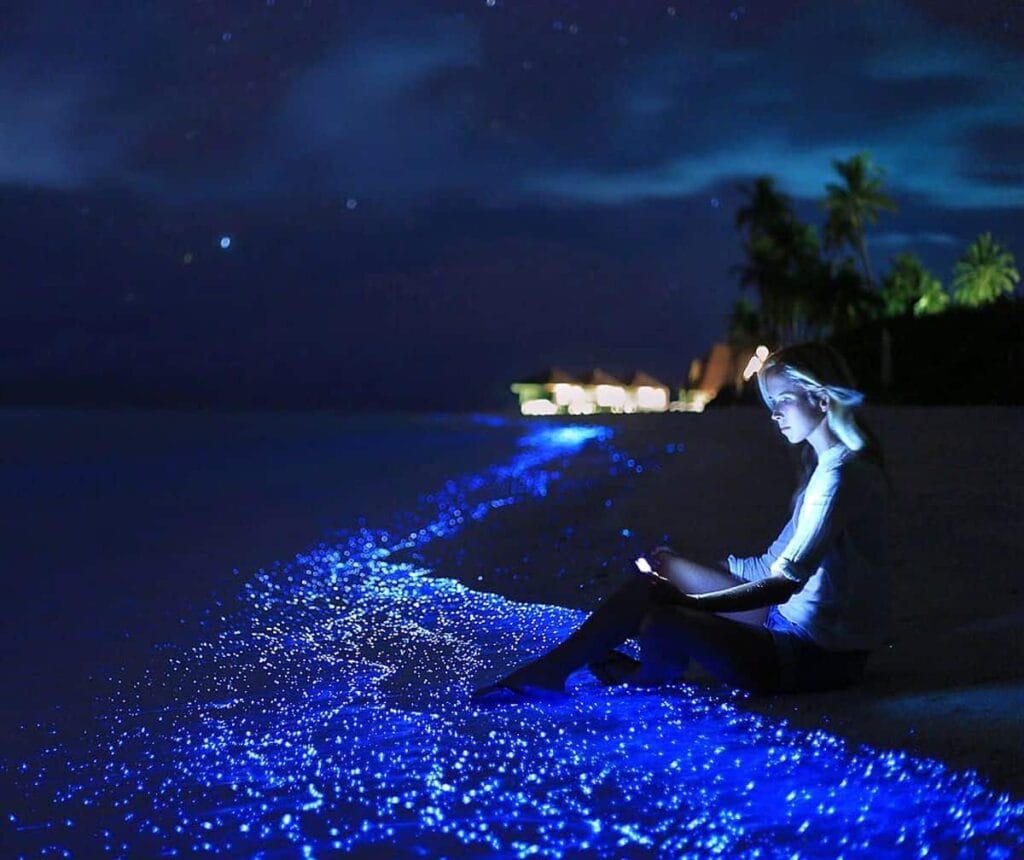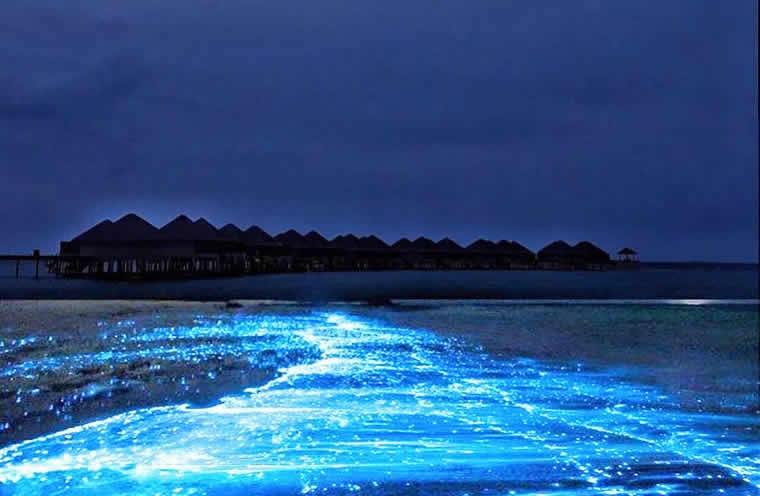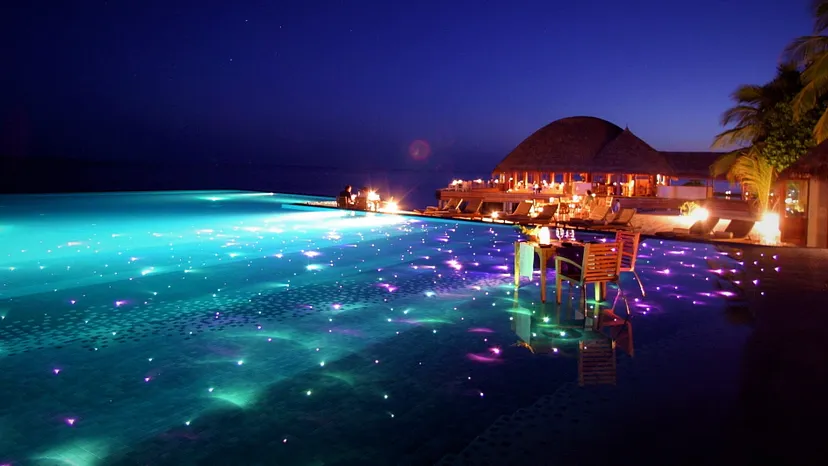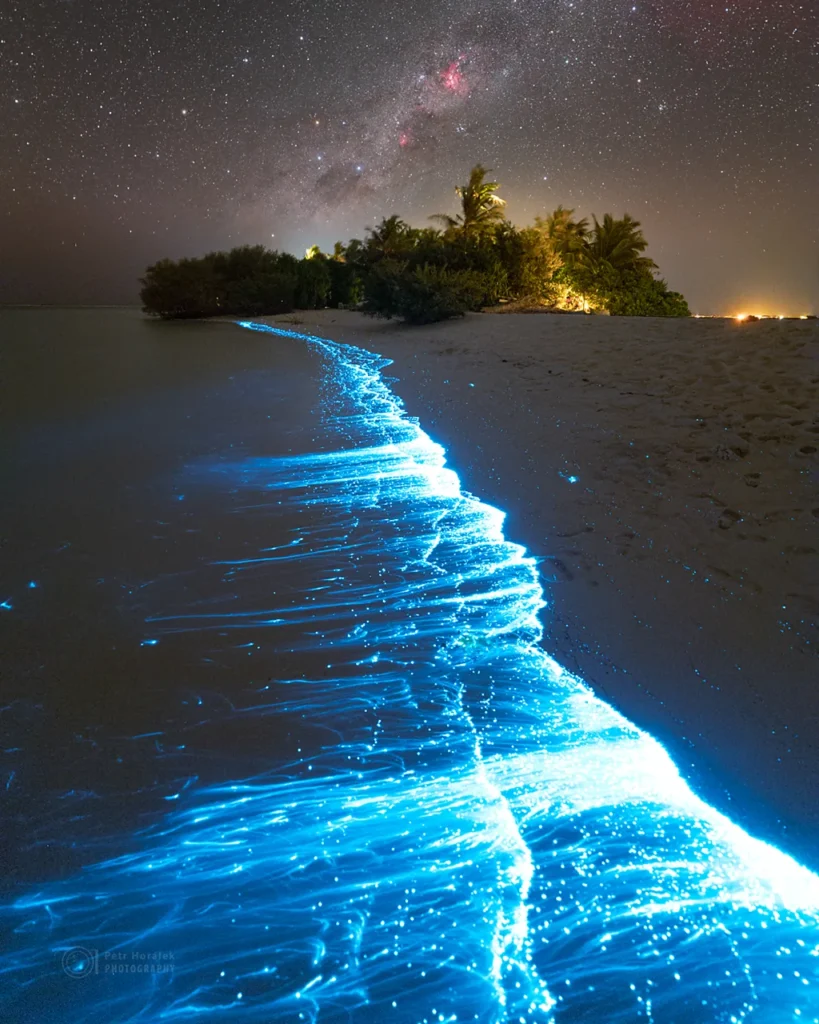The Maldives’ “Sea of Stars” is a blend of natural wonder and myth, drawing countless visitors from around the world. This fascinating phenomenon occurs when bioluminescent plankton light up the ocean, creating a surreal sight where the ocean seems to shimmer under the night sky. While the exact location of this dazzling display is elusive, the experience is one of the most sought-after attractions in the Maldives, despite being part fiction.
Imagine a stretch of the Indian Ocean glowing with a soft blue light, resembling stars that have fallen from the heavens and settled in the water. As waves break onto the shore, they bring along tiny sparkling specks, lighting up the sand briefly before they fade into the darkness. Visitors can walk along the beach, leaving behind a trail of glowing footprints. A simple dip of your toe into the water can send ripples of light across the ocean, as though you are touching a swirling galaxy. This magical phenomenon, known as the “Sea of Stars,” captivates the imagination of travelers and has become a must-see in the Maldives.
Have you ever wondered what it would be like to swim among stars—without leaving Earth? Imagine being surrounded by glowing waters as tiny plankton light up with every movement. Would you be intrigued to experience the Maldives’ “Sea of Stars” and dive into this magical natural wonder?
On the page:
The Illusion of the Sea of Stars

Contrary to popular belief, the Maldives’ famous “Sea of Stars” is not a permanent destination marked on any map. Rather, it’s a breathtaking natural phenomenon caused by bioluminescent plankton. Marine biologist Lauren Arthur, who has spent eight years researching marine life in the Maldives, sheds light on the science behind this dazzling occurrence. According to Arthur, bioluminescence is a chemical reaction that happens when certain organisms produce and emit light, usually when they are disturbed or agitated by movement, like the gentle waves washing ashore or the sweep of a hand through the water.
The plankton responsible for the “Sea of Stars” are minuscule, free-floating organisms carried through ocean currents. However, only specific species of plankton have the capability to produce this enchanting glow, often emitting a neon blue hue that lights up the shoreline. “When people say they want to see the ‘Sea of Stars’ in the Maldives, they’re actually asking to witness a chemical reaction that’s beautifully orchestrated by nature,” Arthur explains.
The phenomenon has captivated the imaginations of travelers worldwide, and while the Maldives is one of the most popular places to observe it, bioluminescent plankton can be found in various parts of the world. Locations like Puerto Rico’s Vieques Island, the Mosquito Bay, and even parts of the United Kingdom have their own share of bioluminescent events. However, seeing the “Sea of Stars” in the Maldives requires the perfect blend of factors: timing, location, and a stroke of luck.
Bioluminescence is most commonly seen on moonless nights when the ocean is dark enough to allow the glowing plankton to stand out. Additionally, certain times of the year are more favorable for spotting this natural wonder. In the Maldives, the months between July and February are generally considered the best period to increase your chances of witnessing the glowing phenomenon. During these times, calm waters and warm temperatures create the ideal environment for the plankton to thrive and illuminate the sea.
The bioluminescent show tends to occur more frequently in areas where plankton populations are dense. Mudhdhoo Island and Vaadhoo Island are among the most famous Maldivian locations for this extraordinary experience, often attracting photographers and nature enthusiasts eager to capture the glowing seascape. Tour operators sometimes offer night excursions specifically aimed at seeing the “Sea of Stars,” but even then, it’s important to manage expectations. Nature remains unpredictable, and sightings cannot be guaranteed.
While tourists flock to see this magical light show, Arthur cautions that human activity and climate change may have an impact on the delicate balance of marine ecosystems. The warming of ocean temperatures and pollution can negatively affect plankton populations, making the phenomenon even more elusive. “It’s a reminder of how intertwined our natural world is,” Arthur notes. “Experiences like these highlight the importance of protecting marine environments so future generations can continue to witness nature’s wonders.”
In essence, the “Sea of Stars” is a fleeting, magical spectacle that showcases the mysteries of the natural world. It’s a stunning reminder of the beauty hidden in the oceans, waiting to be discovered—if only you’re lucky enough to be in the right place at the right time.
Related: 19 Best Beaches in the Maldives You Must See to Realize
How to Maximize Your Chances of Seeing the Sea of Stars

While the Maldives’ famous “Sea of Stars” is not a permanent, fixed attraction, there are ways to increase your chances of witnessing this mesmerizing bioluminescent phenomenon during your visit. Marine biologist Lauren Arthur provides insights into the optimal conditions and strategies to help you make the most of your trip.
Arthur explains that the best time to visit is during the Southwest Monsoon season, which spans from April to October. During these months, ocean currents bring an abundance of plankton from the southwest to the northeast, creating more opportunities to encounter the bioluminescent organisms. The key to seeing this natural light show lies in timing and location, as the glowing plankton are more active and abundant during this period. Additionally, moonless nights provide the darkest conditions, making the glow of the plankton even more vivid against the inky backdrop of the ocean.
For an unforgettable experience, Arthur highly recommends night snorkeling. “You may get lucky and see it while sipping Champagne on the beach,” she says, “but the real thrill is getting in the water with the plankton.” Night snorkeling allows you to be fully immersed in the glowing waters, with every movement you make causing the plankton to light up in a dazzling display. When the water is thick with bioluminescent plankton, simple gestures like waving your hands or kicking your feet create radiant trails of light, giving you the sense that you’re “swimming among the stars.” The sensation of being surrounded by glowing blue light is truly otherworldly, making it a must-do activity for adventurous travelers.
To capture this phenomenon on camera, preparation and technique are essential. Arthur advises turning off all external lights, including underwater torches, to ensure complete darkness. This will make the glow of the bioluminescence stand out more vividly in your photos. Next, move your arms and legs through the water to create enough disturbance to trigger the plankton’s light reaction. Since photographing bioluminescence requires a long exposure time, using a camera with manual settings and a steady hand or tripod will help capture the magic. Smartphone cameras may struggle to capture the glow effectively, so if photography is a priority, consider investing in a high-quality camera designed for low-light conditions.
Several local diving centers, such as Maafushi Dive & Watersports, offer night snorkeling excursions tailored to help you discover the bioluminescent plankton. These tours are often guided by experienced divers who know the best spots and can offer tips on how to get the most out of your underwater adventure. Beyond the thrill of witnessing the Sea of Stars, these excursions provide an opportunity to explore the Maldives’ rich marine ecosystem under the cover of night, where the ocean takes on a new, mysterious life.
In addition to snorkeling, travelers can also enjoy the spectacle from the shore, though the effect is usually more pronounced when you’re in the water. Regardless of where you choose to experience the bioluminescence, the Sea of Stars is a captivating reminder of nature’s wonders and the beauty hidden beneath the ocean’s surface. With the right timing, a sense of adventure, and a bit of luck, you can make memories that will truly shine.
The Legend of Vaadhoo Island

Although the “Sea of Stars” can appear anywhere in the Maldives, two islands have gained fame as the best places to witness this phenomenon: Vaadhoo and Vadoo. These names have become synonymous with the Sea of Stars, especially after viral images in 2013 depicted glowing bioluminescent plankton on the beach. However, this fame is somewhat misplaced. Arthur clarifies that bioluminescent plankton cannot be attracted to any specific location, and the photos likely created an association with these islands purely by coincidence.
Vaadhoo, a small island in Raa Atoll, has capitalized on this reputation. The island, with a population of just 626, has recently opened its first guesthouse, Vaadhoo View Inn. Ismael “Issey” Naseer, the owner, explains that many travelers visit Vaadhoo specifically to see the bioluminescent plankton, thanks to the viral images. Although he cannot guarantee visitors will see it, Naseer estimates that the phenomenon occurs around 90% of the year in some form. The growing tourism around Vaadhoo benefits local businesses, making it a sustainable source of income for the community.
Despite the hype around Vaadhoo, it’s essential to remember that bioluminescent plankton can appear anywhere in the Maldives. Islands with minimal light pollution, such as Fulidhoo in Vaavu Atoll and Dhigurah in South Ari Atoll, provide some of the best conditions for spotting the plankton due to the absence of artificial light.
Capturing the Bioluminescence
Capturing the bioluminescence of the Maldives’ “Sea of Stars” can be both rewarding and challenging for photographers. To successfully capture this elusive glow, having the right camera setup and understanding how to use long exposure techniques are essential. The key to creating stunning images lies in stabilizing your camera with a tripod to avoid any movement during the shot. Since bioluminescence is faint and flickering, your camera needs extra time to absorb enough light.
Recommended settings for photographing bioluminescent plankton include an ISO of 3200 to make your camera sensor more sensitive to light. Pair this with a wide aperture, like f/2.8, to let in as much light as possible. An exposure time of around 1.3 seconds is a good starting point, but you may need to adjust it depending on the strength of the bioluminescence and ambient lighting conditions. Experiment with longer or shorter exposure times to find what works best.
Keep in mind that bioluminescence is fleeting, and it may take several attempts to capture it perfectly. Be patient and ready to adapt to changing conditions. Moving your hands or feet through the water can help trigger the glow, adding a dynamic effect to your photographs and making for a more captivating image.
A Deeper Connection with the Ocean

The Sea of Stars phenomenon highlights the Maldives’ breathtaking marine environment, which is full of life and mystery. Arthur perfectly captures the awe of witnessing bioluminescent plankton: “It’s like little diamonds underwater, and it’s the most beautiful thing you will ever see.”
The Maldives has long been a top destination for those seeking pristine beaches and luxurious resorts. However, for travelers willing to venture beyond the typical tourist experience, the Sea of Stars offers a chance to connect with nature in a profound way. Whether you catch the glowing plankton while lounging on the beach or snorkeling under a starlit sky, the memory of this experience is one that will stay with you forever.
Conclusion
The Sea of Stars, with its elusive nature, adds an element of mystery and wonder to the Maldives. Understanding the science behind bioluminescence and following the right timing and conditions can significantly increase your chances of witnessing this extraordinary phenomenon. Engaging with the natural world in such a profound way deepens travelers’ connection to the rich marine ecosystem of the Maldives. For many, seeing the glowing waters is not just a visual spectacle, but an unforgettable, magical experience that enhances the beauty of this already stunning destination. It’s an opportunity to witness nature’s brilliance firsthand.




1 thought on “The Maldives’ Sea of Stars: Explore Its Enchanting Glow”